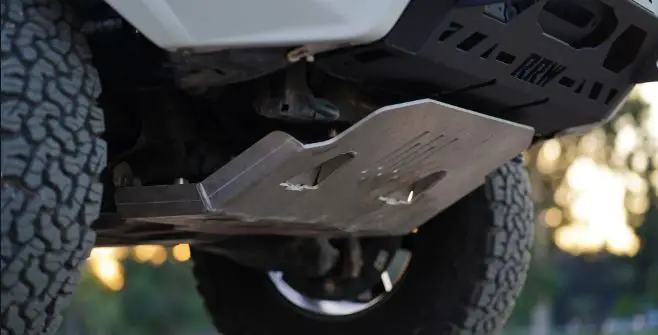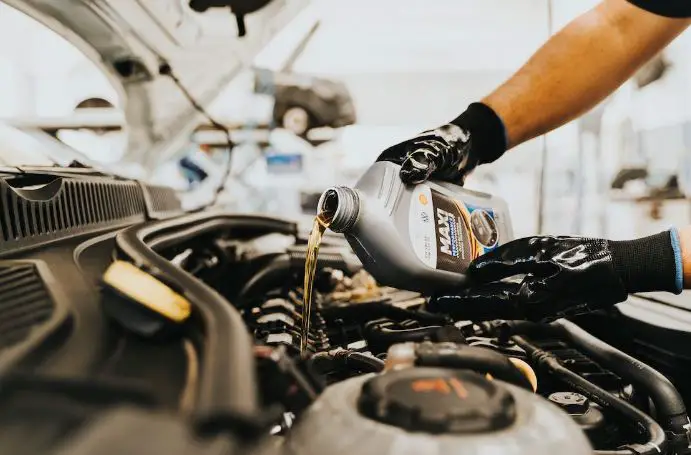Have you ever looked at a car parked in the street or in a lot somewhere and thought to yourself, “wow, check out the skid plate on that car”? If you’re confused by that question, don’t be, because of course, you haven’t ever thought that, and neither has anyone else. First of all, it’s because skid plates aren’t fitted to every vehicle. Second, it’s located on the underside of a vehicle where few think to look at a glance.
The skid plate is one of the most understated and underrated components of a vehicle, which is why we decided to write a blog post all about this humble vehicle part.
What is a Skid Plate?
A skid plate is a specially formed metallic sheet plate that is fitted to the undercarriage of a vehicle, typically at the front end of the vehicle. The express purpose of the skid plate is to protect the undercarriage from abrasion and collision with uneven surfaces. To that end, they are very durable and made from abrasion-resistant materials (see more below), and can take a lot of punishment.
As we touched on in the introduction, skid plates are not common to all vehicles out there. Cars designed for city use, for example, will rarely come with skid plates because they invariably drive on very flat and even ground, and usually have enough clearance for anything that the city might throw at them. Some cars with a very low-lying profile, however, such as sports cars, might be fitted with one as they are susceptible to abrasion when moving from flat to a sudden incline, which can happen even in the city.
Where skid plates are really useful, however, is in the world of adventure and off-road driving. Vehicles like the Jeep Wrangler, or perhaps a Ram 1500, Ford F-150 or other vehicle that is favored for off-road driving, trail driving and more, are very likely to have skid plates fitted whether they have good ground clearance or not. This is because it’s impossible to predict changes in off-road terrain, especially when attempting rock crawling and similar activity.
Aerodynamics
One more added function and benefit of adding a skid plate to a car is the potential for enhancing the aerodynamic qualities of a vehicle. A skid plate can work to actively reduce turbulence and allow air to pass more smoothly across the underside of the vehicle. That’s greatly to your benefit when you’re driving at speed or want a more comfortable experience driving on the highway, for example.
What are Skid Plates Made From?
Given their function, skid plates have to be made from abrasion-resistant materials, and they are. The two most common metals used in skid plates are good-old sturdy steel, as well as more contemporary and lightweight aluminum. Skid plates made from aluminum are generally a little cheaper and won’t add too much weight to your vehicle, but the flip side of that is that you pay something of a premium in strength. Aluminum plates will never be as heavy-duty as the steel plates.
You pay more for steel plates, but it’s the only material that will do when you’re talking about heavy-duty protection for the undercarriage of your vehicle. Aluminum plates can sometimes grip the surface they are skidding on because of their lightweight structure. Steel is stronger and will skid over things more easily and with less chance of undue wear and tear.
Other materials used for skid plates include hard plastic and carbon fiber, which offer strength while being even lighter than aluminum.
Skid Plate Vs. Belly Pan – Is There a Difference?
You might have been led to believe that belly pan was basically just another word for skid plate, but that’s not the case. The two components have certain features in common. They’re both fitted to the underside of the vehicle, and they both serve as protective coverings to the undercarriage, but they are different in their makeup and precise function.
A belly pan is fitted to the underside of a car mostly to protect against potential damage caused by road debris, rock chips and other such materials from causing damage as they are hurled about the place as cars ride on and over the roads. You fit a belly pan to the underside of the car for the same reason that you might coat the front side of your car with paint protection film. It provides a physical barrier from common types of debris that fly about on the road.
Skid plates are stronger and ready to take more heavy abuse and damage than belly pans because they are put in place to protect the vehicle when it might actually make physical contact with the ground.
What is the Typical Cost of a Skid plate?
Skid plates are varied and numerous in the aftermarket parts scene, and the prices you might pay are about as varied, too. Skid plates can range from as little as $30-50 up to $500 depending on the size, material, strength and brand. That’s the component cost, but if you also have the skid plate fitted by a professional, then you’re looking also at another $40-50 in labor costs.
The good news is that it’s relatively easy to install a skid plate, with most attaching with just a handful of screws. This keeps labor costs down, too, and it isn’t a time-consuming task.
Are Skid Plates Legal?
Skid plates are technically legal, but they may not be entirely safe for street vehicles or racing vehicles, which we’ll cover in more detail in the pros and cons section. In short, however, there is something to be said for emergency procedures involving an engine when skid plates are involved.
Can You Fit Skid Plates Yourself?
Skid plates are relatively simple to install and generally fit in place with just 4 or more screws. The mounts you need are already there in most cases, and all you need are a ratchet, a few sockets, and a jack stand to get the job done.
Where Can You Buy A Skid Plate?
You can find a whole host of skid plate options for various models here
Pros and Cons of Skid Plates – Are They Worth It?
To wrap up our blog on skid plates, let’s consider the pros and cons of these components.
Pros:
- Protection for critical components exposed in the undercarriage, especially from speed bumps and uneven ground
- Protection for critical components from off-road terrain threats like rocks
- Lower service requirements for these parts because of added protection
- Improved aerodynamics on vehicles with a flat floor
Cons:
- Has to be removed when servicing undercarriage, which is annoying
- Reduces safety as it prevents engine from falling away in a serious accident, leading to a dangerous engine possibly falling into the passenger cabin instead of behind the vehicle
In the end, it can’t be denied that if you drive an expensive car that is exposed regularly to the threats of the terrain beneath it — whatever they are — then an extra layer of “armor” is always beneficial. The dangers presented above have to be taken seriously, however, and drivers should consider the implications carefully, perhaps only using the skid plates at times when they know they are useful, and not just leaving them on there permanently.
Go Home









